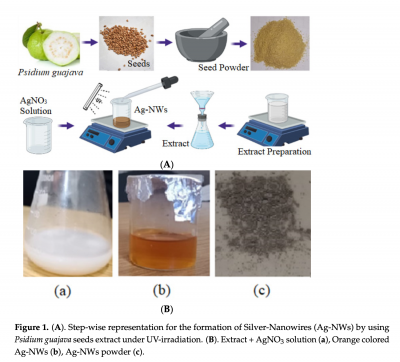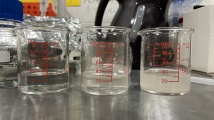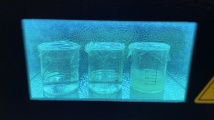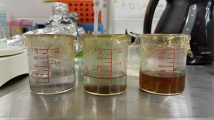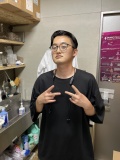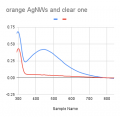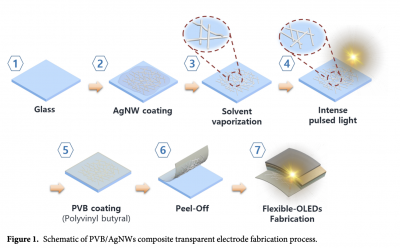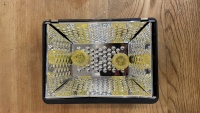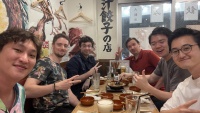Guava seeds synthesized silver nanowires
Contents
Part I, the bio synthesis of Ag-NWs
This experiment is composed with two existed paper, one is to synthesis AgNWs with Psidium Guajava seed, and the other one is to synthesis transparent conductive layer by transferring AgNWs which are light sintered by Riso print Gocco lamps. Guava seeds contain some compounds, such as polyphenols and alkaloids, which can reduce silver nitrate under certain conditions, thereby promoting the growth and stability of silver nanowires. These compounds acted as reducing agents and stabilizers during the preparation process, thus enabling a green synthesis method without external stabilizers. For the light sintering of AgNWs, a local Japanese toy kit "RISO PRINT GOCCO LAMP" is used to replace the IPL (intense pulsed light) in the original paper. The sintered AgNWs is formed on glass and then be transferred to a PVB film.
The first try of Ag-NW bio synthesis in BioClub Tokyo
3 beakers of mixtures of silver nitrate and guava seed extraction were created with different concentration of guava seed extraction, 1. silver nitrate solution mixed with distilled water, 2. silver nitrate solution mixed with guava seed extraction heat stirred for 50 mins, 3. silver nitrate solution mixed with guava seed extraction heat stirred for 4 hours. All beakers were given UV exposure for 4 hours, the color of the second and 3rd mixture were changed from milky white to orange, it is filtered by filter paper and a final orange solution is collected. The final sample is centrifuged and the aggregations are also collected. Only the orange final solution was analyzed with UV-vis.
Analyzing result
UV-vis the final orange solution. The Ultraviolet–visible spectroscopy test was made by Shohei Asami, member of Bioclub. The final result can be found here. The curve match up the graph in the paper but overall lower, indicates the low density of silver nano particles.
The scanning electron microscopy is kindly supported by Joakim Reuteler in ETH Zurich. 2 samples of guava seeds synthesised AgNWs were prepared, one is AgNW solution dried on glass, the other one is aggregation collected from the solution. However we didn't find any wire-alike shape, indicating the failure of the nano wire synthesis.
- SEM and UV-vis of the final solutions
Part II, Gacco Lamp Sintered AgNWs PVM film
Continued with the first part, in the original paper, the AgNWs is sintered by IPL (intense pulsed light) but due to the high price of IPL, I decided to try something else. I found a type of light bulb that generate sudden high heat in a Japanese toy kit RISO PRINT GOCCO LAMP which is introduced by the founder of Bioclub, Georg Tremmel. The original purpose of the bulb is to create mask for riso print. The original usage please visit RISO PRINT GOCCO LAMP tutorial. The follow on practices is documented in page Conductive thin coating made of AgNWs.
A conductive, uniform, and ultra-smooth flexible transparent composite film is produced by embedding silver nanowires (AgNWs) into poly(vinyl-butyral) (PVB) without pressure or high-temperature annealing.
Preferences
- Ali, Faisal, Zahid Ali, Umer Younas, Awais Ahmad, Ghulam Mooin Ud Din, Muhammad Pervaiz, Rafael Luque, et al. 2021. “UV-Light Mediated Biosynthesis of Silver Nanowires; Characterization, Dye Degradation Potential and Kinetic Studies.” Sustainability 13 (November): 13220. https://doi.org/10.3390/su132313220.
- Lv, Pengfei, Huimin Zhou, Min Zhao, Dawei Li, Keyu Lu, Di Wang, Jieyu Huang, Yibing Cai, Lucian Amerigo Lucia, and Qufu Wei. 2018. “Highly Flexible, Transparent, and Conductive Silver Nanowire-Attached Bacterial Cellulose Conductors.” Cellulose 25 (6): 3189–96. https://doi.org/10.1007/s10570-018-1773-8.
- Ferraro, Giovanni, and Emiliano Fratini. 2019. “A Simple Synthetic Approach To Prepare Silver Elongated Nanostructures: From Nanorods to Nanowires.” Journal of Chemical Education 96 (3): 553–57. https://doi.org/10.1021/acs.jchemed.8b00628.
- Padhi, Santwana, and Anindita Behera. 2022. “Chapter 17 - Biosynthesis of Silver Nanoparticles: Synthesis, Mechanism, and Characterization.” In Agri-Waste and Microbes for Production of Sustainable Nanomaterials, edited by Kamel A. Abd-Elsalam, Rajiv Periakaruppan, and S. Rajeshkumar, 397–440. Nanobiotechnology for Plant Protection. Elsevier. https://doi.org/10.1016/B978-0-12-823575-1.00008-1.
- Lee, Dong Jun, Youngsu Oh, Jae-Min Hong, Young Wook Park, and Byeong-Kwon Ju. 2018. “Light Sintering of Ultra-Smooth and Robust Silver Nanowire Networks Embedded in Poly(Vinyl-Butyral) for Flexible OLED.” Scientific Reports 8 (1): 14170. https://doi.org/10.1038/s41598-018-32590-0.
- Jin, Hwa-Young, Jae-Yup Kim, Jin Ah Lee, Kwangsoo Lee, Kicheon Yoo, Doh-Kwon Lee, BongSoo Kim, et al. 2014. “Rapid Sintering of TiO2 Photoelectrodes Using Intense Pulsed White Light for Flexible Dye-Sensitized Solar Cells.” Applied Physics Letters 104 (14): 143902. https://doi.org/10.1063/1.4871370.
